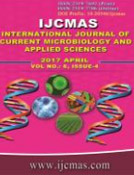


 National Academy of Agricultural Sciences (NAAS)
National Academy of Agricultural Sciences (NAAS)

|
PRINT ISSN : 2319-7692
Online ISSN : 2319-7706 Issues : 12 per year Publisher : Excellent Publishers Email : editorijcmas@gmail.com / submit@ijcmas.com Editor-in-chief: Dr.M.Prakash Index Copernicus ICV 2018: 95.39 NAAS RATING 2020: 5.38 |
Conidial germination, appressoria formation and penetration are most important stages of infection process in rice blast pathogen i.e. Magnaporthe oryzae, and temperature rise due to climate change is expected to change infection process of pathogen. Temperature has significant influenced on all components of infection process i.e. conidial germination, appressoria formation, germ tube growth. All the components of infection process are higher at optimal temperature (27°C) as compared to both suboptimal (22°C) and supra-optimal (32°C) temperatures for M. oryzae. Appressoria formation and spore germination are faster in optimal temperature and too slower at supra-optimal temperature, which is an indirect indication that M. oryzae is not capable to cause infection at higher temperature. Interestingly, change in temperature from sub optimal to optimal temperature has not affected rates of conidial germination and rate of appressoria formation. Similar kind of trend observes for germ tube growth, and after appressoria formation re-growth is observed, which is an indication of diauxic growth in M. oryzae. This is the first report that only 4 to 5 percent of appressoria are available to cause infection in natural condition. Dynamics of appressoria and spore germination helps in understanding of infection process and development of new management strategies for rice blast.
 |
 |
 |
 |
 |